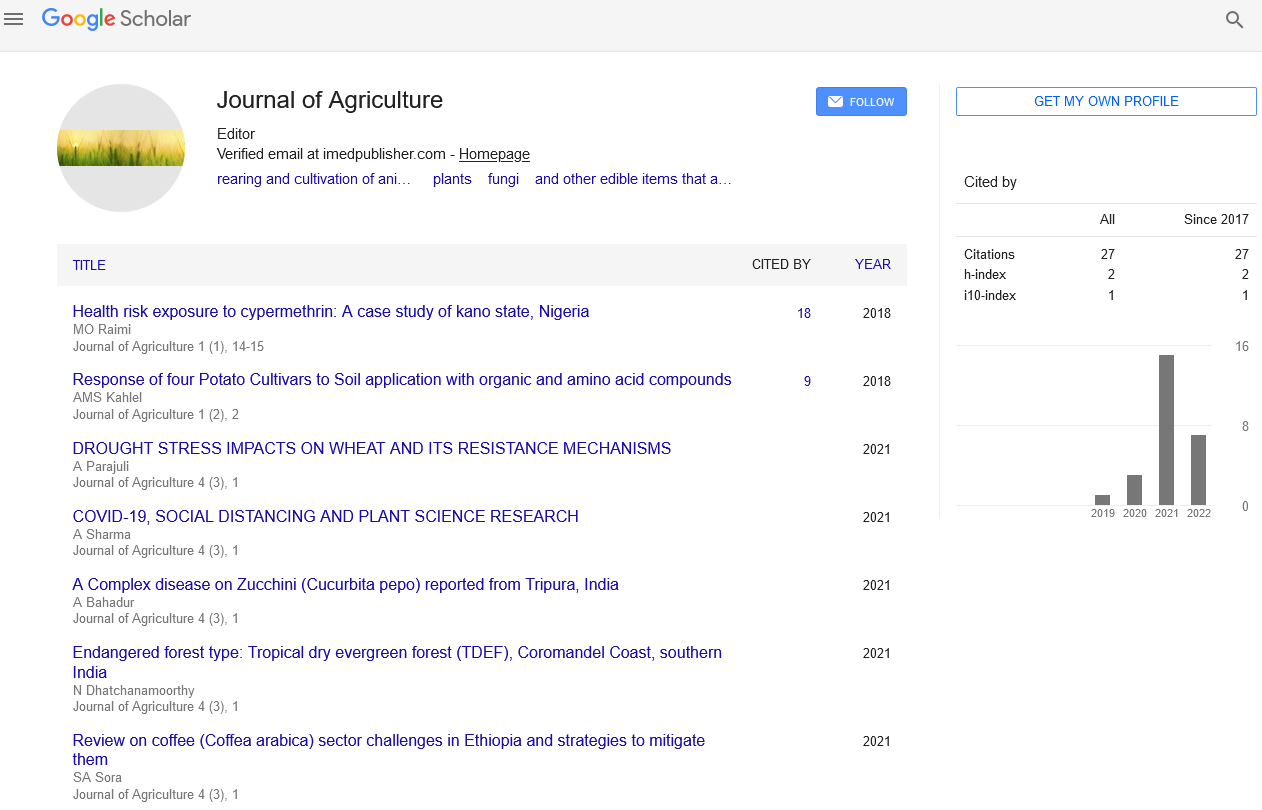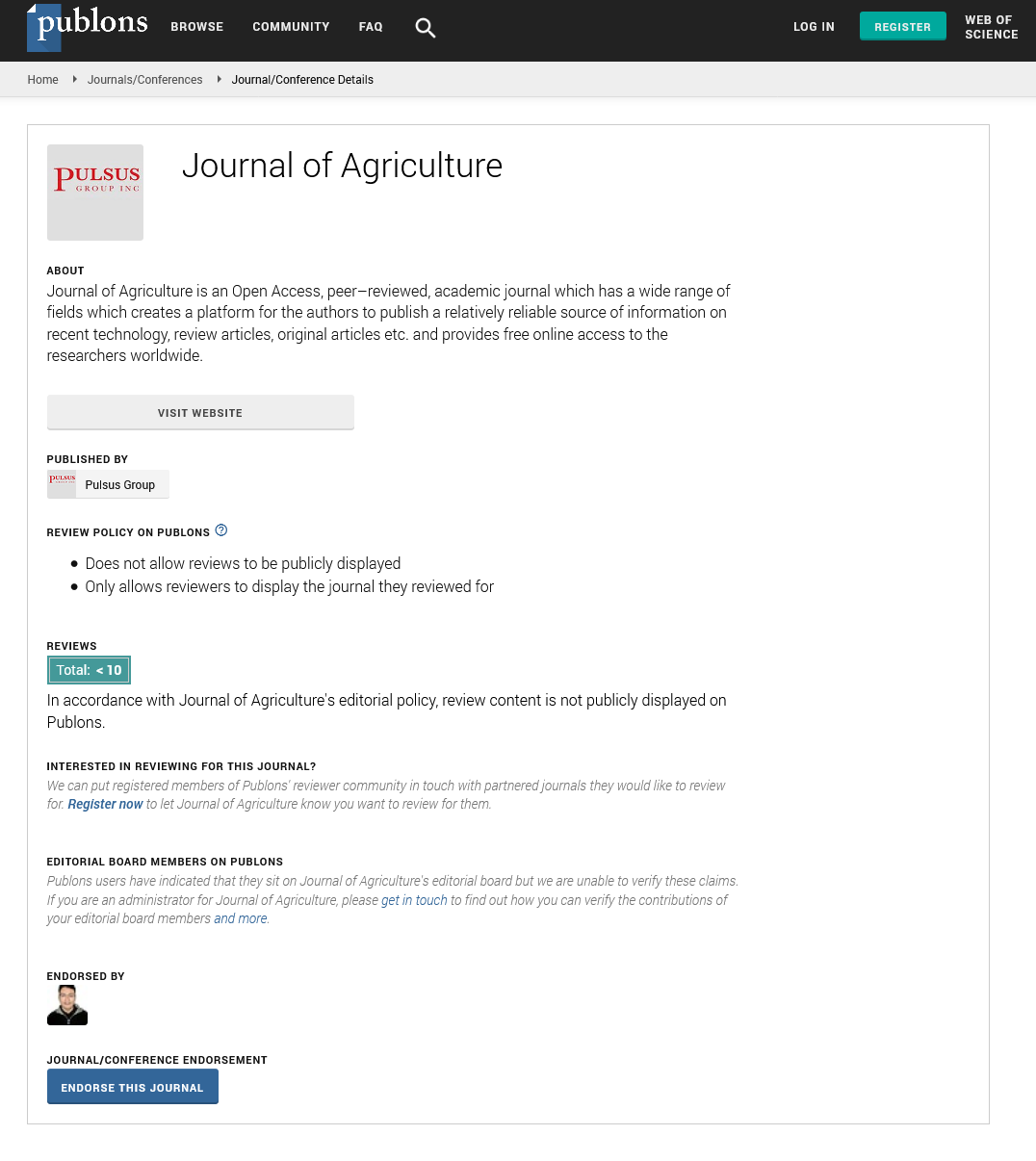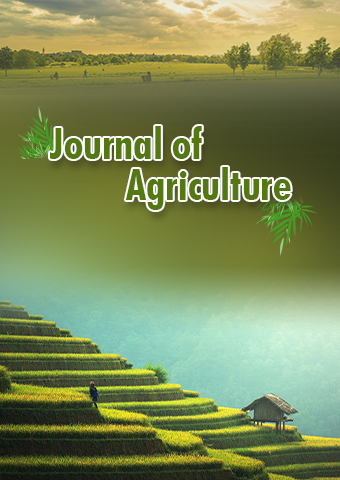Editorial - Journal of Agriculture (2023) Volume 6, Issue 4
Using data-intensive plant breeding and genetic gain as an indication for agricultural research and development will speed up agriculture.
Ashok K Mishra*
Department of Forest Resources, Nanjing Forestry University, Jiangsu, China
Department of Forest Resources, Nanjing Forestry University, Jiangsu, China
E-mail: Mkashok65@gmai.com
Received: 01-Aug-2023, Manuscript No. jagri-23-108631; Editor assigned: 03-Aug-2023, Pre-QC No. jagri-23-108631 (PQ); Reviewed: 17- Aug-2023, QC No. jagri-23-108631; Revised: 22-Aug-2023, Manuscript No. jagri-23-108631 (R); Published: 29-Aug-2023; DOI: 10.37532/ jagri.2023.6(4).112-114
Abstract
Acceleration of genetic growth has become a central goal of global plant breeding in recent years The South, the availability of new information technologies and the combination of biological interest in crop improvement increasing the cost-effectiveness of breeding programs. This article explains the concept genetic benefit, the conditions for its increase as an indicator of agricultural development and more widely the consequences of this movement, with special attention to the changing knowledge management systems of plant breeding, social and political implications for smallholders and climate-adaptive agriculture. Let’s analyze how the priority of the variables used in the derivation of the indicator when deciding on agricultural policy affects the relationship between development goals and practice. We conclude that genetic benefit should not be considered a The main indicator of agricultural development, if there is no information on other key areas (incl agricultural biodiversity, seed systems and the different effects of climate change on soils, crops and communities), such as and tools to assess the pros and cons of seed selection, boost management and evaluation with genetic benefit as the key indicator.
Keywords
Genetic • Plant breeding • Boost management • Agricultural policy
Introduction
Agriculture plays a pivotal role in sustaining human civilization by providing food, fiber, and fuel. As the global population continues to grow, there is an increasing demand for agricultural products. To meet these challenges, researchers and scientists are turning to data-intensive plant breeding and genetic gain as a catalyst for agricultural research and development. This article explores the potential of harnessing data-driven approaches to accelerate agriculture, enhance crop yields, and ensure food security for the future [1].
Genetic gain as an indicator
The rate of genetic gain (ΔG), also known as the response to selection, has been defined as “the improvement in average genetic value in a population or the improvement in average phenotypic value due to selection within a population over cycles of breeding”. Put another way, it is a measure of the change in the population average for a given trait or index (set) of several traits that is attributable to heritable genetic effects, and therefore to the selection decisions made within a breeding programme. Notably, the rate of genetic gain does not require or produce direct knowledge about the genetic architecture of any individual or the population [2, 3]. Rather, it uses statistical methods to account for the interaction of genotypic effects with environmental and error effects in phenotypic evaluation data collected from plants or animals in the field.
Data-intensive plant breeding: The key to unlocking crop potential
Traditional plant breeding methods have been essential in improving crop varieties over the centuries. However, the process of developing new plant varieties can be time-consuming, resource-intensive, and highly dependent on trial and error. The advent of data-intensive plant breeding brings revolutionary changes to the field by leveraging advanced technologies like genomics, big data analytics, and artificial intelligence (AI) [4].
Genomic sequencing allows researchers to unravel the genetic code of crops, providing insights into specific traits associated with productivity, resilience, and nutrition. Coupled with vast datasets on environmental conditions, soil characteristics, and historical performance, dataintensive plant breeding empowers researchers to make more informed decisions in selecting and breeding crops tailored to particular regions and climates [5].
Harnessing genetic gain for sustainable agriculture
Genetic gain refers to the progressive improvement of crop traits over successive generations, achieved through selective breeding and the incorporation of desirable genetic material. By focusing on specific traits, such as drought tolerance, disease resistance, and nutrient content, genetic gain accelerates the development of crops with improved performance and adaptability [6].
Data-intensive plant breeding complements genetic gain by enabling researchers to identify and prioritize traits that align with evolving agricultural challenges. This ensures that crop breeding efforts are targeted and efficient, leading to the rapid development of more resilient and high-yielding varieties [7].
The advantages of data-intensive approaches
Precision agriculture: Data-driven approaches enable farmers to adopt precision agriculture techniques. By employing real-time data from sensors, satellites, and drones, farmers can optimize inputs like water, fertilizers, and pesticides, reducing waste and maximizing crop yields.
Rapid trait identification: With advanced genomic tools, researchers can swiftly identify genes responsible for specific traits. This expedites the breeding process and allows for the development of crop varieties that meet consumer demands and market trends [8].
Climate adaptation: Climate change poses significant challenges to agriculture. Dataintensive plant breeding facilitates the development of climate-resilient crops, ensuring continued productivity in the face of unpredictable weather patterns.
Data sharing and collaboration: Dataintensive approaches encourage collaboration between public and private stakeholders, leading to a more comprehensive understanding of crop genetics and accelerating the pace of agricultural innovation [9].
Overcoming challenges and ethical considerations
While data-intensive plant breeding holds immense potential, there are challenges that need to be addressed. These include data privacy concerns, ensuring equitable access to technology and data, and the need for regulatory frameworks to govern gene-editing techniques responsibly [10].
Conclusion
Data-intensive plant breeding and genetic gain have the potential to revolutionize agriculture by accelerating the development of crop varieties that can meet the challenges of a growing population and a changing climate. By harnessing the power of data, researchers and farmers can work together to achieve sustainable, efficient, and productive agriculture, ensuring food security for generations to come. However, responsible implementation and equitable distribution of benefits are crucial to ensuring the success and acceptance of these transformative approaches in the agricultural sector.
References
- Shah J, Ali A. Combined effect of Bacillus fortis IAGS 223 and zinc oxide nanoparticles to alleviate cadmium phytotoxicity in Cucumis melo. Plant PhysiolBiochem. 158, 1-12(2021).
- Zabrieski Z, Morrell E, Hortin J et al. Pesticidal activity of metal oxide nanoparticles on plant pathogenic isolates of Pythium.Ecotoxicology.24 (6), 1305-1314(2015).
- Harris P, Gupta H, Bhagat R et al. Effects of different metal oxide nanoparticles on plant growth. Recent Advances and Impacts. 259-282(2021).
- Kiran P, Adi J. Aquaculture role in global food security with nutritional value: a review.TranslAnimSci. 3(2), 903-910 (2019).
- Dempewolf H, Baute G, Anderson J et al. Past and future use of wild relatives in crop breeding.Crop Sci.57, 1070-1082(2008).
- Matin Q. Role of new plant breeding technologies for food security and sustainable agricultural development.Applied Economic Perspectives and Policy.42, 129-150 (2020).
- Zamir D. Improving plant breeding with exotic genetic libraries.Nat Rev Genet.2,983-989(2001).
- Morrell PL, Edward S, Ibarra JR et al. Crop genomics: advances and applications.Nat Rev Genet. 13, 85-96 (2012).
- Davies W, Paul J. An historical perspective from the green revolution to the gene revolution. NutrRev. 61, 124-134(2003).
- Moose SP, Mumm RH. Molecular plant breeding as the foundation for 21st century crop improvement.Plant physiology,147,969-977(2008).
Indexed at, Google Scholar, Crossref
Indexed at, Google Scholar, Crossref
Indexed at, Google Scholar, Crossref
Indexed at, Google Scholar, Crossref
Indexed at, Google Scholar, Crossref
Indexed at, Google Scholar, Crossref
Indexed at, Google Scholar, Crossref
Indexed at, Google Scholar, Crossref


